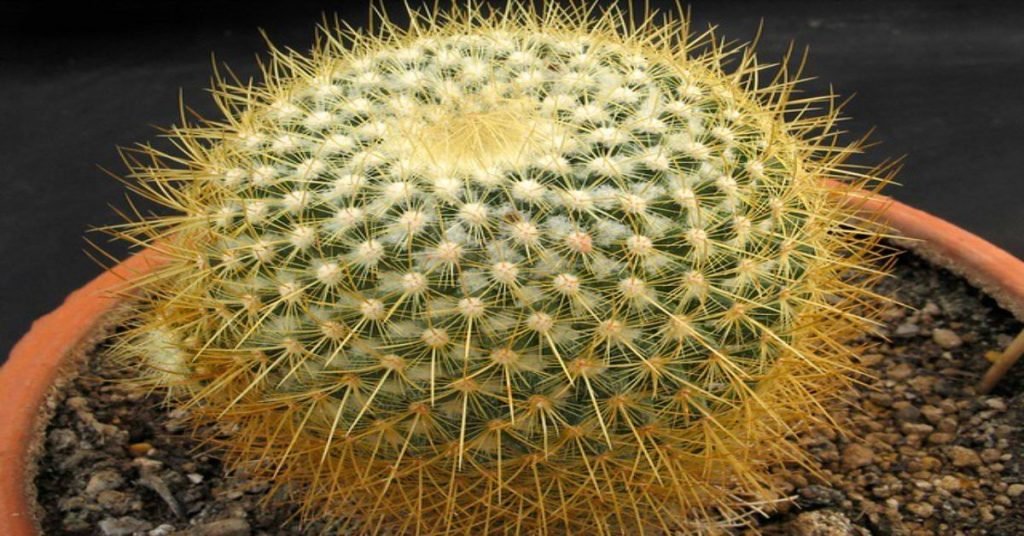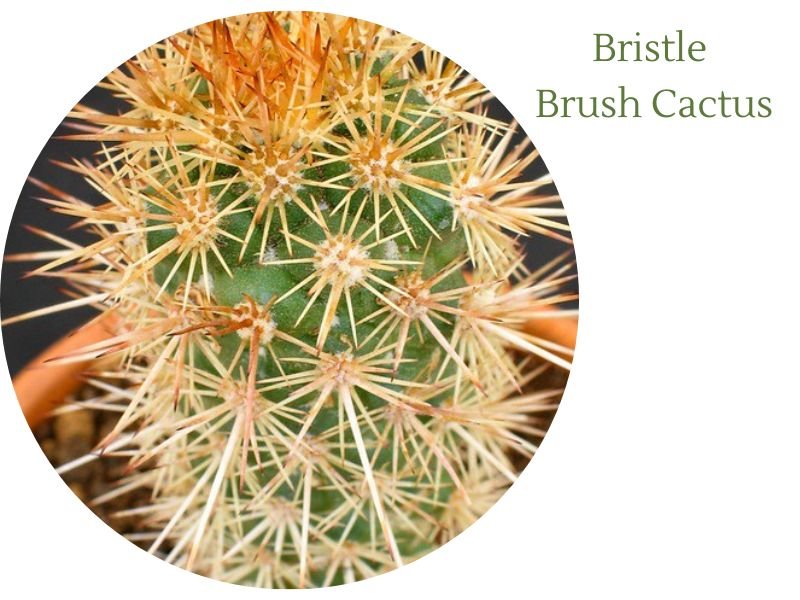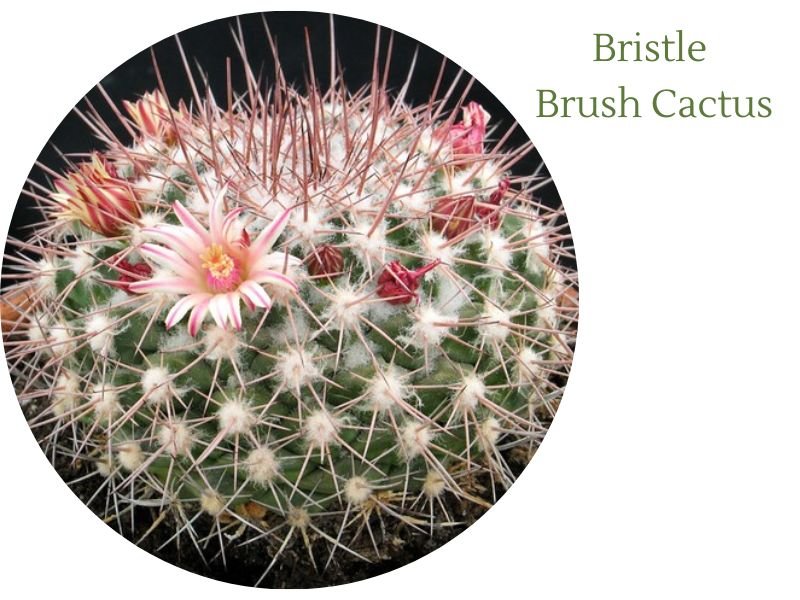Welcome to the world of bristle brush cactus, a unique and fascinating plant that is sure to capture your interest. Whether you are an experienced gardener or a novice, understanding how to care for this plant is essential for its survival. I’ve seen too many people buy a beautiful cactus only to watch it wither away due to neglect or improper care.

Table of Contents
Brief Overview of Bristle Brush Cactus
Bristle brush cactus is a type of cylindrical cactus that grows in dense clusters. It has long, thin spines that are white or yellow in color and cover the entire surface of the plant.
The Bristle Brush Cactus is named so due to its distinctive feature of having bristle-like spines covering its surface. These spines are numerous, slender, and often densely clustered, resembling the bristles of a brush. They give the cactus a unique and textured appearance, which led to its common name, “Bristle Brush Cactus.”
The spines serve various purposes, including protection against predators and reducing water loss, and their arrangement contributes to the cactus’s overall aesthetic appeal.
The body of the cactus is green or blue-green and can reach up to 12 inches in height. It’s truly a stunning sight when it blooms with bright pink flowers.
Importance of Understanding How to Care for It
It’s not enough just to admire this beautiful plant from afar. If you’re going to take on the responsibility of caring for it, you need to understand what it needs in order to thrive. Neglecting your bristle brush cactus can lead to a number of problems, including stunted growth, insect infestations, and even death.
But don’t let that scare you off! With the right knowledge and attention, caring for bristle brush cactus can be a rewarding experience.
Not only will you be able to enjoy its striking appearance, but also its resilience and ability to adapt make it an ideal choice for any home or garden setting. In short, if you’re willing to put some effort into nurturing this amazing plant species, then your efforts will surely be rewarded tenfold!
What is Bristle Brush Cactus?

The Bristle Brush Cactus, scientifically known as Mammillaria spinosissima, is a fascinating species of cactus. Here are some interesting facts about this plant:
Physical Description
- Appearance: The Bristle Brush Cactus is a small-sized cactus that typically grows to about 4 to 6 inches (10 to 15 centimeters) in height. It has a globular or cylindrical shape with numerous tubercles, which are small bumps on the surface of the cactus.
- Spines: As its name suggests, this cactus is covered in a dense cluster of bristle-like spines. The spines are usually white or yellowish in color and can be quite long. They provide the plant with protection against predators and also aid in reducing water loss through transpiration.
- Flowers: During the blooming season, which is typically in spring or early summer, the Bristle Brush Cactus produces beautiful flowers. The flowers are small and usually appear in shades of pink or purple. They are tubular in shape and can be found growing from the top of the cactus.
- Habitat: This cactus is native to Mexico and can be found growing in the wild in arid regions, rocky slopes, and desert areas. It is well adapted to survive in harsh conditions with limited water availability and high temperatures.
- Cultivation: The Bristle Brush Cactus is a popular choice among cactus enthusiasts and collectors. It can be cultivated both indoors and outdoors, given the right conditions. It prefers well-draining soil and requires ample sunlight to thrive. However, it is important to protect it from freezing temperatures.
These plants belong to a larger group called series Polyacanthae. In this series, the plants have very small flowers. They also have many spines, which are divided into central spines (some of which are hooked) and several radial spines. Unlike another group called series Supertextae, the spines of series Polyacanthae do not cover the plant stem completely. The members of series Polyacanthae include M. backebergiana, M. duoformis, M. magnifica, M. spinosissima, and M. rekoi.
Habitat and Origin
Bristle brush cacti are native to many tropical regions throughout the world, including Central America, South America, Mexico, and the Caribbean Islands. They grow best in warm climates where temperatures range between 70°F – 90°F (21°C – 32°C). In their natural habitat, they often grow on trees as epiphytes or on rocks as lithophytes.
Types of Bristle Brush Cacti
The Mammillaria genus is the largest within the Cactaceae family, comprising over 200 species of round-shaped cacti with small spines and flowers. These plants are primarily found in the Western Hemisphere, particularly in Mexico.
While the Cactaceae family includes medicinal genera like Opuntia sp., which are used as food and have economic significance in horticulture, the Mammillaria species are predominantly used for decorative purposes in gardens worldwide.
Popular species like M. rhodantha, M. spinosissima, M. hahniana, M. crucigera, M. candida, M. albilanata, and M. muehlenpfordtii are frequently employed in spring flower festivals, where they are adorned with artificial red and yellow flowers since they rarely bloom naturally in non-simulated habitats.
In their natural form, their flowers exhibit diverse colors and are arranged in rings around the column. Thus, the polyphenolic profile and biological activities of the Mammillaria genus remain unexplored.
Why Choose Bristle Brush Cactus?

Bristle Brush Cactus is an exceptional plant that has a unique set of features and benefits. There are plenty of reasons to choose it over other cacti, succulents, or houseplants.
The first reason is that they have an interestingly bizarre appearance. With long, slender arms covered in bristly spines, the Bristle Brush Cactus looks like something from another world.
Another great reason to select this plant is its resilience and low maintenance requirements. If you don’t have a lot of time for watering or fertilizing your plants, the Bristle Brush Cactus might be the perfect choice for you.
This cactus can thrive in dry conditions with minimal attention. It can tolerate both high and low temperatures making it suitable for most environments.
Unique Features and Benefits
Bristle Brush Cactus has a range of unique features and benefits that make it worth considering as your next house plant or garden addition. One of its most impressive features is its ability to store water in its stem for long periods of drought – up to six months!
This means that it can survive even if you forget to water it for weeks on end. Another outstanding attribute of the Bristle Brush Cactus is its beautiful flowers which bloom in the summer months.
These flowers are usually white but can also be pink, yellow, or red depending on the species. They add an extra touch of beauty and vibrancy to your home or garden.
The potential of Cancer Treatment
A recent study has unveiled a promising potential for Bristle Brush Cactus medical benefit.
This study is the first to examine seven different types of Mammillaria cacti. It looked at the chemicals in these cacti and how they affect cancer, antioxidants, and bacteria. The researchers found that all the cacti contained different types of chemicals called phenolic acids.
Some cacti had more of certain chemicals than others. These chemicals had effects against cancer cells and showed strong antioxidant properties. They also had some ability to fight bacteria. The study suggests that Mammillaria cacti could be a good natural source of helpful chemicals.
Decorative Uses in Homes and Gardens
If you’re looking for a unique way to decorate your home or garden with plants, then Bristle Brush Cactus might be just what you need! Its spiny arms make for excellent decoration on their own or combined with other plants such as succulents or ferns. In terms of indoor decor, Bristle Brush Cactus is a great addition to any space with natural light.
It’s great for adding a touch of greenery to offices, living rooms, or even bathrooms. In the garden, these cacti can be planted in containers or directly in the ground to create an unusual and exotic look.
There are many reasons why you should consider choosing Bristle Brush Cactus as your next plant purchase. Whether it’s for its unique appearance, resilience, or decorative uses, this cactus has numerous benefits that make it an excellent addition to any home or garden.
How to Care for Bristle Brush Cactus
Light requirements: The Sunshine Enthusiast
Do not underestimate the importance of proper lighting when it comes to bristling brush cactus care. This plant is a sunshine enthusiast and thrives in bright, direct light.
Place it near a south-facing window or outside in areas with full sun exposure. However, be cautious not to expose it to too much direct sunlight as this can scorch the plant’s delicate skin and cause permanent damage.
If you live in an area with cloudy weather or limited sunlight, consider supplementing the plant’s lighting needs with grow lights. These lights mimic natural sunlight and allow for optimal growth and development of your bristle brush cactus.
Watering needs: Less is More
One of the biggest mistakes new growers make when caring for their bristle brush cactus is overwatering. This species is drought-tolerant and does not require frequent watering like other plants.
In fact, less is more when it comes to watering your bristle brush cactus. Water your plant only when the soil has completely dried out, usually once every two weeks during the growing season.
During winter months, reduce watering frequency even further as the plant enters dormancy mode. Additionally, be mindful of humidity levels in your home or garden as excessive moisture can lead to fungal growth and rotting roots.
Soil type and fertilization: Keep It Simple
The ideal soil mix for bristle brush cactus should be well-draining and have low organic matter content. A good mix would include coarse sand, perlite, gravel, or pumice mixed with regular potting soil. As for fertilization, keep things simple by using a balanced fertilizer mix during the growing season once every month or two at most.
Over-fertilizing can harm the plant, so be cautious. Remember, bristle brush cactus thrives in poor soils and does not require excessive feeding to grow.
Temperature and humidity considerations: Desert-like conditions
Bristle brush cactus originates from desert regions, so it is no surprise that it prefers hot and dry conditions. Keep your plant in a warm area with temperatures around 70-85°F during the growing season. During winter months, reduce temperatures to around 50-55°F to simulate dormancy.
Avoid exposing your bristle brush cactus to sudden temperature changes or drafts as this can stress or damage the plant. Additionally, maintain low humidity levels of around 25-30% by placing a dehumidifier near the plant or using a fan to circulate air.
By following these care guidelines for your bristle brush cactus, you can ensure that your plant thrives and flourishes for years to come. Remember, this unique and beautiful species requires minimal input for maximum output!
Common Issues with Bristle Brush Cactus

Pests and Diseases: Don’t Let Them Win
As a proud plant parent, there is nothing more disheartening than seeing your beloved cactus fall victim to pests or diseases. While bristle brush cacti are generally hardy plants, they are still susceptible to common issues like scale insects, mealybugs, and rot.
To keep these pesky problems at bay, be sure to inspect your cactus regularly for any signs of infestation or damage. If you do detect an issue, act quickly by removing any affected areas and treating the plant with an appropriate pesticide or fungicide.
Overwatering or Underwatering Issues: Finding the Right Balance
One of the most common mistakes new plant parents make is over- or under-watering their plants. Bristle brush cacti are no exception to this rule.
While they can withstand periods of drought, they also require regular watering during their growing season (spring through summer). The key is finding the right balance between too much and too little water.
A good rule of thumb is to wait until the soil is completely dry before watering again. And remember, it’s better to be underwater than overwater – excess moisture can quickly lead to root rot and other issues.
Sunburn or Frost Damage: Protect Your Cacti From Extreme Temperatures
Bristle brush cacti are native to hot, arid regions – which means they thrive in bright sunlight and warm temperatures. However, that doesn’t mean they’re immune to damage from extreme heat or cold. Sunburn can occur if your cactus is suddenly exposed to intense sunlight without being properly acclimated first (think: a shaded indoor plant suddenly placed outside on a hot summer day).
Similarly, frost damage can occur if your cactus is exposed to temperatures below freezing for extended periods of time. To protect your plant, be sure to gradually introduce it to new environments and temperatures, and avoid exposing it to extreme conditions whenever possible.
Tips for Successful Growth
Propagation Methods: Multiply Your Cactus Collection
It’s always exciting to see your bristle brush cactus grow and thrive – but why stop at just one? With a little bit of know-how, you can easily propagate new plants from cuttings or offsets. Simply take a clean, sharp knife or scissors and cut a piece of the cactus stem (making sure to leave a small section of the base intact).
Allow the cutting to dry out for several days before planting it in a well-draining potting mix. Water sparingly until the cutting roots begin to grow.
Pruning Techniques: Shape Your Cacti into Works of Art
Bristle brush cacti are known for their unique shapes and textures – but sometimes you might want more control over their growth patterns. That’s where pruning comes in!
By selectively removing stems or branches, you can shape your cactus into whatever form you desire (within reason). Just be sure to use clean, sterile tools and make cuts at an angle to prevent water from pooling on the surface.
Repotting Guidelines: Give Your Cacti Room to Grow
As your bristle brush cactus grows, it will eventually outgrow its pot and require repotting. This is especially important if you notice signs of root crowding or lack of growth. When repotting, choose a container that is slightly larger than the current one and fill it with a well-draining soil mix.
Gently remove the cactus from its old pot (being careful not to damage any roots) and place it in the new container. Water sparingly until the plant has had a chance to acclimate to its new surroundings.
Conclusion
Bristle brush cacti are fascinating and unique plants that can add a touch of desert-style charm to any home or garden. By understanding their physical characteristics and following proper care guidelines, you can enjoy happy and healthy cacti for years to come.
Whether you’re a seasoned plant parent or just starting out, don’t be afraid to experiment with different propagation methods, pruning techniques, and soil mixes – after all, no two cacti are exactly alike! So go forth and let your bristle brush cacti thrive – you won’t regret it.

Gardening is my passion and growing plants indoors has always been a stress relief for me. Grow a banana tree in my apartment once (although failed to produce bananas).






